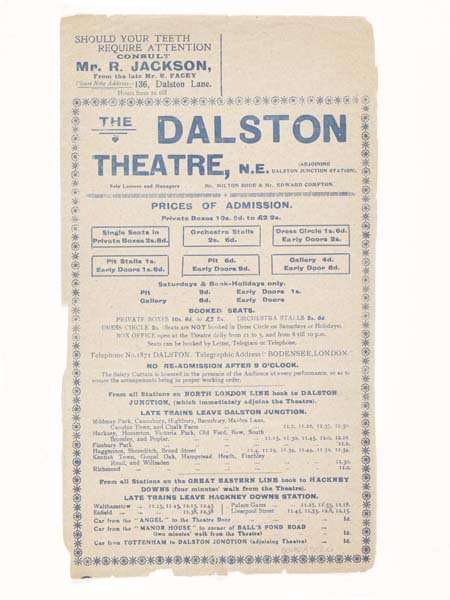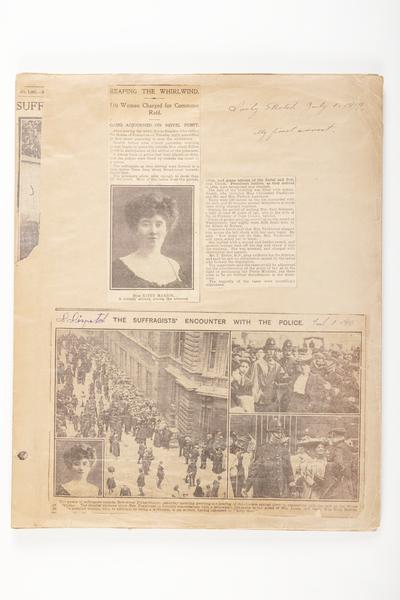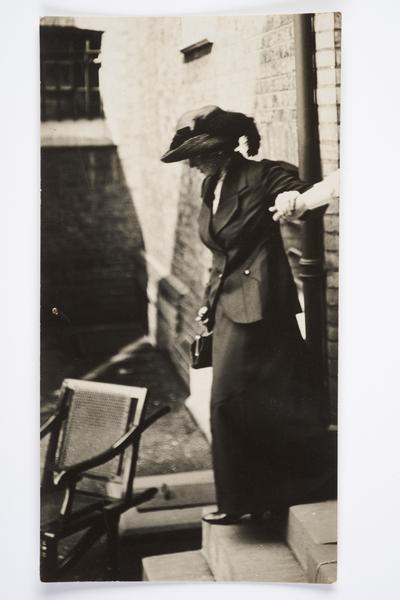Kitty Marion: Actor & Suffragette
Kitty Marion was a successful actor and a daring activist who fought for votes for women as part of the Suffragette movement.
1871–1944

Kitty Marion under arrest in Wales in 1912, having heckled the Chancellor, David Lloyd George.
A relentless militant campaigner
At its most extreme, the Suffragettes’ 1906–1914 campaign used attacks on property to promote its cause. Winning votes for women became a dangerous business – and Kitty Marion was right in the thick of it.
This prominent Suffragette set fire to a racecourse grandstand, smashed windows, went to prison and refused to eat – all to confront the government’s refusal to let women take part in Parliamentary elections.

A postcard showing the Suffragette Kitty Marion. It's signed: "Yours militantly, Kitty Marion".
Marion’s acting career
Katherina Maria Schafer was born in Germany in 1871. Aged 15, she came to England in 1886 to perform in variety theatre, and adopted the stage name Kitty Marion.
Our collection features many playbills and programmes from her shows, including London music hall performances at the Palace Theatre in East Ham in 1907, and the Dalston Theatre, where she played Prince Charming in a pantomime.

An advert for a performance at the Palace theatre, East Ham featuring Kitty Marion, who is described as a "Refined Vocal Comedienne".
While working as a performer, she found that theatre managers in charge of casting would sometimes expect sexual favours in return for work.
In 1908, Marion joined the Women’s Social Political Union (WSPU). The WSPU, led by Christabel and Emmeline Pankhurst, adopted a strategy of militant action to win women the vote. Its followers became known as Suffragettes.

The stands at Hurst Park racecourse burned down by Kitty Marion.
“In her scrapbook... she proudly kept a record of newspaper stories about WSPU arson attacks”
She went to prison multiple times
In total, Marion went to prison five times for her militant action.
Marion was first sent to prison in June 1909 for throwing a stone at a post office window. Released in December, she went on to perform in the Christmas pantomime season.
In March 1912 Marion took part in the Suffragette window-smashing campaign, using a hammer to damage buildings on Regent Street.
And in the same year, she was one of several Suffragettes who heckled the Chancellor David Lloyd George at a meeting in Wales. The audience turned hostile, attacking Marion and her fellow protestors.
Prison didn’t stop her protests
While in Holloway Prison, Marion protested by setting fire to her cell.
She also refused to eat, and was force-fed as a result – held down, and given food through a tube.
From 1909, Suffragette prisoners frequently went on hunger strike in protest against the government’s refusal to treat them as political prisoners.
Fearing that these hunger strikes might lead to the death of a prisoner, in 1913 the government passed the "Cat and Mouse" Act.
Hunger-striking prisoners were released to recover from their strike, only to be arrested again when they appeared in public.
During her last spell in Holloway Prison, Marion was released several times and force fed 232 times over a 14-week period.
Starting fires
Marion started fires outside of prison too. In her scrapbook, which is part of our collection, she proudly kept a record of newspaper stories about WSPU arson attacks, several of which she admitted responsibility for.
In 1913, Marion and Clara Giveen started a fire which destroyed the grandstand at Hurst Park racecourse in Surrey. It’s also likely Marion was responsible for the arson attack on the house of Arthur du Cros, an MP.
A new cause: birth control
After the First World War broke out in 1914, the UK government began deporting people of German heritage. Marion was eventually allowed to move to the USA, where she lived for the remainder of her life, and died in 1944.
While in America, Marion found a new fight – campaigning with Margaret Sanger to promote and legalise contraception. Marion helped set up the first birth control clinic in the United States in 1921.














